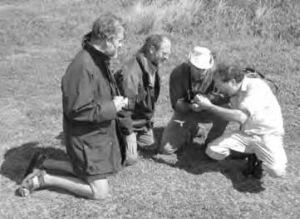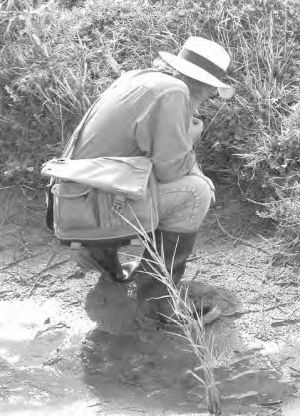|
I wrote in Mollusc World 2 about the activities of the two UK BAP Steering Groups during 2003. Since then each group has met again to continue its work in furthering the objectives of the UK BAP process. 1. The UK BAP Terrestrial Mollusc Steering Group (17th – 19th August 2004) A field study centre at Halsannery, near Bideford, North Devon was the venue for the sixth UK BAP Terrestrial Steering Group meeting. The group reviewed actions of the previous meeting undertaken during the last year. One major focus of the meeting was to review the UK BAP targets for each of the target species published nine years ago. In that time considerable progress has been made in increasing knowledge of the distribution and status of each of the five 1 species covered by the group. The targets review requires that Steering Groups plan for ‘secure status’ 2 for each species and to identify manageable and realistic targets to achieve these goals. During the meeting the group also discussed the future research requirements for each species and agreed new work programmes for the period 2005 – 2007. There was a brief discussion on possible changes to the UK BAP Priority Species listing which is being reviewed in 2006 (see item on page 22). Barry Colville offered his resignation from the group as he felt that his contribution was now of less significance than following the Group’s formation. Barry, who has played a major role in the group since its inception particularly with regard to his active field work in Northern England and Scotland on certain Vertigo species and Catinella arenaria, was thanked for his valuable contributions to the Group’s work. Barry’s place will be filled by Geri Holyoak, The Conchological Society’s Non-marine Recorder. The Group spent the morning of 19th August at Braunton Burrows guided by John Breeds (Site Manager) and also David & Geri Holyoak and Martin Willing, who have jointly been studying Catinella arenaria (the sand bowl amber snail) populations over a number of years and were monitoring the distribution throughout the system. The management history of the site and some recent problems were explained to the group, who also saw representatives of the rare snail in one of its dune slack habitats. (see images right). The meeting was attended by Adrian Fowles (Chair: Lead Agency, CCW); Daryl Buck (Environment Agency), Roger Key (English Nature), Alisa Watson (English Nature), Athayde Tonhasca (Scottish Natural Heritage), Barry Colville (Conchological Society), Ian Killeen (Malacological Services), Martin Willing (Conchological Society). 1. The UK BAP Freshwater Mollusc Steering Group (17th February 2005) This group met at the Environment Agency Offices in Reading. The agenda was similar to that of the Terrestrial Steering Group, focussing upon work undertaken on the six target species 3 since the last meeting as well as the BAP Targets Review and the UK BAP Priority Species lists, both of which are being reviewed in 2005. The meeting was attended by Juliette Hall (Chair: Lead Agency, Environment Agency); Sheila Wilson (Environment Agency), Catrin Grimsted (Environment Agency), Glen Meadows (Environment Agency), Huw Jones (Environment Agency: Wales), Geri Holyoak (Conchological Society), Ian Killeen (Malacological Services), Martin Willing (Conchological Society), David Aldridge (Conchological Society) 1 The Terrestrial Steering Group covers the BAP Priority species, Vertigo moulinsiana, V. geyeri, V. genesii, V. angustior and Catinella arenaria. 2 ‘Secure status’ is when (1) the populationsize and range of a species is either stable or increasing and /or (2) the population dynamics and meta-poulation structure of the species indicate that it is likely to be able to maintain itself on a long-term basis within its natural habitats. 3 The Freshwater Steering Group deal with the five BAP Priority Species Anisus vorticulus, Segmentina nitida, Pisidium tenuilineatum, Myxas glutinosa, and Pseudandonta complanata as well as the rare RDB species Gyraulus acronicus. |
|
The UK Biodiversity Action Plan (BAP) Steering Group Meetings
Issue
8
Page
21



